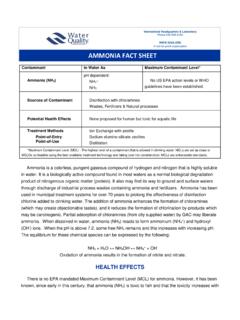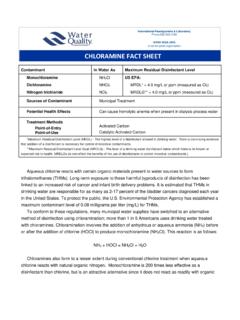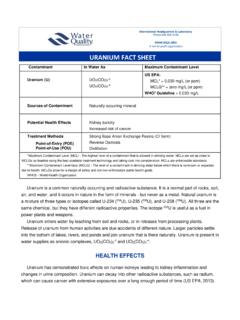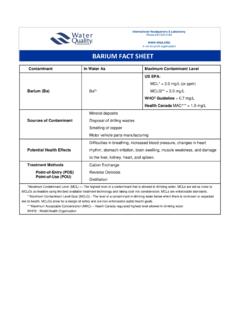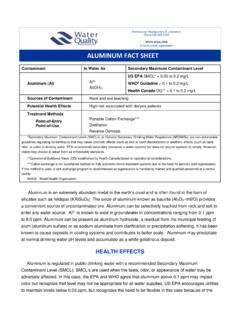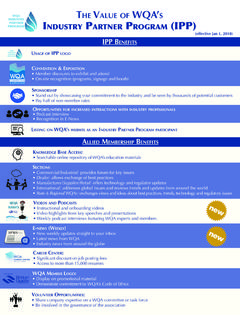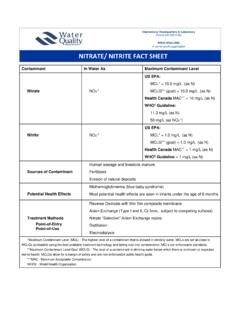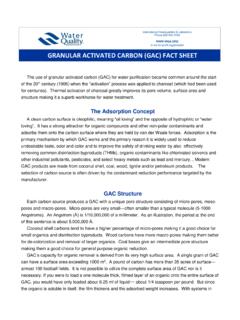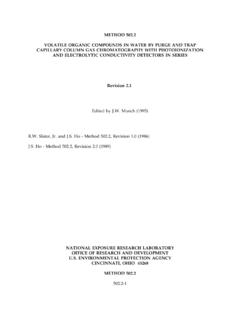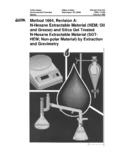Transcription of ARSENIC FACT SHEET - Water Quality Association
1 Contaminant In Water As Maximum Contaminant Level ARSENIC (As) When pH = 6-10 As(III), arsenite as H3 AsO3 and H2 AsO31- As(V), arsenate as H2 AsO41- and HAsO42- US EPA: MCL* = mg/L (or ppm) MCLG** = zero WHO Guideline = mg/L Sources of Contaminant Leaching from natural deposits Wood preservatives, pesticides, industrial deposits Petroleum production Semiconductor manufacture Coal power plants Potential Health Effects Serious skin problems, endocrine disruptor Causes Cancer skin, bladder, lung, kidney, liver, prostate Harms cardiovascular &nervous systems Treatment Methods Point-of-Entry Point-of-Use Iron oxide/ hydroxides Activated alumina Iron based specialty media impregnated or coated with iron oxide/hydroxides Distillation Titanium oxy/hydroxide Anion Exchange (strong base anion exchange resins) Manganese greensand Reverse osmosis (RO) *Maximum Contaminant Level (MCL) - The highest level of a contaminant that is allowed in drinking Water .
2 MCLs are set as close to MCLGs as feasible using the best available treatment technology and taking cost into consideration. MCLs are enforceable standards. **Maximum Contaminant Level Goal (MCLG) - The level of a contaminant in drinking Water below which there is no known or expected risk to health. MCLGs allow for a margin of safety and are non-enforceable public health goals. WHO - World Health Organization The presence of ARSENIC (As) in nature is due mainly to natural deposits of metalloids in the earth s crust and usually in ancient rock formations. ARSENIC enters ground Water through erosion or from man-made sources such as wood preservative, petroleum production, semi-conductor manufacture or due to misuse of animal feed additives and ARSENIC -containing pesticides ( Paris green). Since soluble ARSENIC is tasteless and colorless, a chemical Water analysis is necessary to detect its presence. Higher levels of ARSENIC tend to be found more in ground Water sources than in surface Water sources (lakes and rivers) of drinking Water .
3 Compared to the rest of the United States, the western states have more Water systems with ARSENIC levels greater than 10 micrograms per liter ( g/L, ppb). ARSENIC FACT SHEET International Headquarters & Laboratory Phone 630 505 0160 A not-for-profit organization WQA Technical Fact SHEET : ARSENIC Parts of Midwest, New England, and Texas have some systems whose current ARSENIC levels are greater than 10 g/L (or ppb). Figure 1: US Geological Survey Map of ARSENIC in Groundwater (USGS, 2005). In ground Water , ARSENIC can combine with other elements to form inorganic as well as organic compounds; the inorganic derivatives are considered more toxic than the organic forms. The inorganic forms usually exist in potable Water in two chemical valence states: as arsenite (As III) or arsenate (As V). The arsenite species exists in anaerobic/anoxic (reduced or low oxygen) waters as H3 AsO3 or H2 AsO31-. The specific form depends on the pH of the Water .
4 At pH , arsenite exists as a 50-50 mixture of H3 AsO3 and H2 AsO31-. At less than pH , arsenite exists primarily as the neutral (non-ionized) species, H3 AsO3 (can be written as HAsO2). The arsenate species exists in aerobic (oxidized) waters up to pH 9 as a mixture of H2 AsO41- and HAsO42-, and as a 50-50 mixture at pH In order to find out whether your drinking Water contains ARSENIC , please refer to the Natural Resources Defense Council (NRDC) website. NRDC has analyzed data compiled by the US Environmental Protection Agency (US EPA) in drinking Water in 25 states over a period of 18 years. You can also get information on the presence of ARSENIC in your drinking Water from your local Utility or state EPA. You can also call USEPA s drinking Water hotline (1-800-426-4791) for more information. WQA Technical Fact SHEET : ARSENIC As mentioned above, two conditions that dominate the behavior of ARSENIC in Water are its state of oxidation (valence) and the pH of the Water .
5 Generally, aerated surface waters contain arsenate (As V) while the reductive well waters contain arsenite (As III). Municipally treated waters containing free available chlorine (FAC) will generally oxidize arsenite (As III) to the arsenate (As V) form. NOTE: Chloraminated Water utilizing only monochloramine (NH2Cl) will not completely oxidize As III to As V. Generally, negatively charged (ionized) As V (as H2 AsO41- and HAsO42-) is much easier to remove than uncharged As III (as H3 AsO3 or HAsO2). Tests to determine the concentration of each form, also known as speciation, must be performed in order to choose the proper removal technique. Current technology suggests that several techniques may be used to remove the arsenate, arsenite and organic forms of ARSENIC from drinking Water . These include iron oxide/hydroxides and activated alumina media filtration, manganese greensand filtration, strong base anion exchange resins, distillation, and reverse osmosis.
6 Some specialty media include iron oxide/hydroxide-impregnated or coated activated alumina and anion exchange resins, as well as titanium oxy/hydroxide. HEALTH EFFECTS Toxicity of ARSENIC to humans is well known, and ingestion of as little as 100 milligrams (mg) can result in severe poisoning. Amounts in Water are normally much lower, but low concentrations still can lead to chronic symptoms. The effect of ARSENIC , when ingested in small amounts, appears very slowly. In fact it may take several years for the poisoning to become apparent. Chronic arsenosis can in its most extreme form, cause death. Inorganic ARSENIC is absorbed readily from the gastrointestinal track and becomes distributed throughout the body tissues and fluids. Ingestion of inorganic ARSENIC leads to a number of health effects as follows: Cancerous effects: skin, bladder, lung, kidney, nasal passages, liver and prostate cancer Non-cancerous effects: cardiovascular, pulmonary, immunological, neurological and endocrine disruption effects The US EPA s final ARSENIC rule was issued in 2001.
7 It revises the Maximum Contaminant Level (MCL) from 50 g/L to 10 g/L and sets the Maximum Contaminant Level Goal (MCLG) to zero in the drinking Water . Both community Water systems (CWS) and non-transient, non-community Water systems (NTNCWS) are required under this rule to reduce the ARSENIC concentration in their drinking Water to10 g/L or lower. For details of toxicological and epidemiological effects of ARSENIC in drinking Water , please refer to the National Research Council report published by National Academic Press given in the references below. WQA Technical Fact SHEET : ARSENIC TREATMENT METHODS Residential Point-of-Entry Iron oxide/hydroxides Activated alumina Anion exchange in a fixed bed (requires regeneration) Manganese greensand (requires regeneration) Titanium oxy/hydroxide Iron-doped anion resin and activated alumina Residential Point-of-Use Iron oxide/hydroxides Activated alumina with or without iron oxide coating Anion exchange Distillation Titanium oxy/hydroxide Reverse osmosis (RO) Municipal Iron oxide/hydroxides Activated alumina Anion exchange in a fixed bed (requires regeneration) Coagulation with iron hydroxide (initially added as FeCl3) followed by filtration though a bed of adsorptive granular media Visit or to search for products certified to WQAS-200, NSF 53, 58, 62 for ARSENIC reduction.
8 Iron oxide, iron hydroxide and iron coated activated alumina filtration media have shown effectiveness in removing both arsenite (As III) and arsenate (As V) from levels of over 50 parts per billion (ppb) or g/L to effluent levels below 5 ppb ( g/L) for greater than 10,000 bed volumes before exhaustion. These removal systems operate best at pH less than 8. Iron-based technologies can be susceptible to competitive adsorbates, such as silicates, vanadates ( , VO43-) and phosphate. It has be demonstrated that each mg/L increase in phosphate above mg/L will reduce adsorption capacity by roughly 30% (US EPA, 2014). Therefore, a Water analysis should be conducted prior to the selection of a removal technology. For reductive Water from wells, where As III is expected to predominate, an oxidation step such as chlorination or ozonation is necessary if a technique other than iron based systems are used ( , RO and anion exchange). Potassium permanganate (KMnO4) is also very effective in oxidizing As III to As V.
9 Passing aqueous solutions of As III through a fixed-bed column of manganese dioxide (MnO2) also has been shown to oxidize As III to As V and, at the same time, provide some removal capability. Iron based specialty media are also easy to operate and have a higher capacity than AA media. Some media can remove both arsenite and arsenate even though capacities may differ. The pH can be as high as for many of these media, however the lower the pH the better the removal performance. WQA Technical Fact SHEET : ARSENIC Activated alumina (AA) has easy maintenance and potential for non-hazardous waste disposal after exhaustion. It is highly selective for As V , so arsenites (As III) must be oxidized to arsenate (As V) and the pH lowered, preferably to < or even lower if silica is present. Distillation is useful when only small quantities of drinking Water are involved. It has been shown to reduce ARSENIC to less than 2 ppb ( g/L). Strong base anion (SBA) type I & type II resins in Cl- form can effectively remove As V (arsenate, as H2 AsO41- or HAsO42-).
10 However sulfate, selenium, fluoride and nitrate ions present in Water will compete with As V ions (H2 AsO41- and HAsO42-) for exchange sites and may produce earlier exhaustion. Anion exchange is not effective to remove As IIIi (arsenite, as H3 AsO3 or HAsO2), since they are not charged (ionized), so it is necessary to oxidize it to As V by an acceptable technique (chlorination, permanganate or ozonation). Optimum pH for anion exchange removal is approximately >7. Regeneration can be done with brine (NaCl) solution. Manganese greensand is best used for only As V reduction, so if As III is present, it should first be oxidized to As V. NOTE: Prior to installing and utilizing regenerative treatment technologies or bulk disposable adsorptive media, it is important to contact the local, regional or state regulatory authorities to determine proper disposal requirements. Thin film composite (TFC) Reverse Osmosis membranes are best used for only As V reduction, so, again, As III should be oxidized by chlorination or ozonation, or other oxidation technique acceptable for the specific application that will not harm the membrane.
